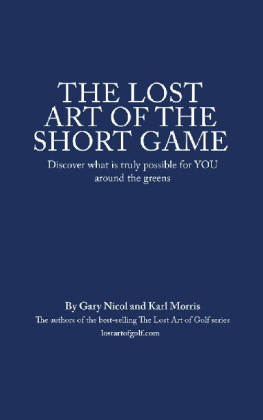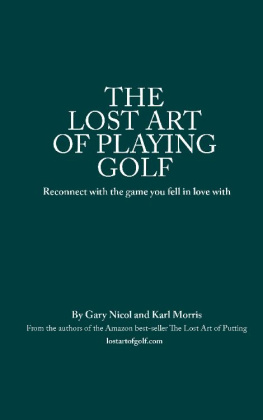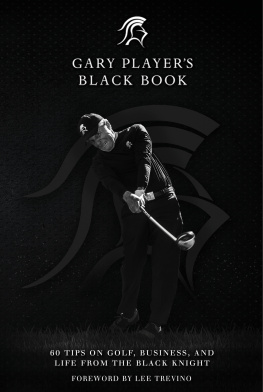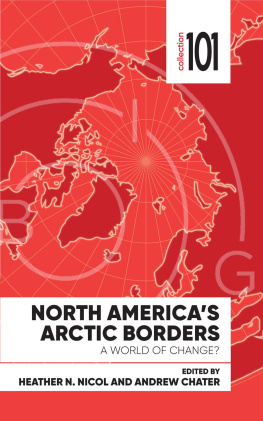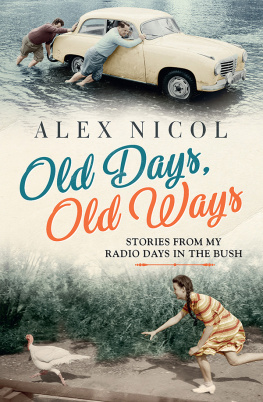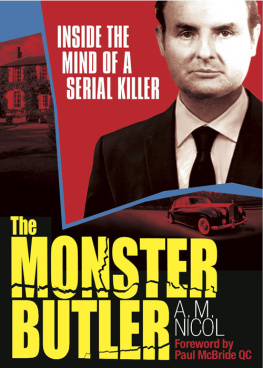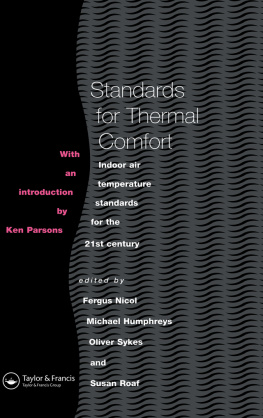Gary Nicol - The Lost Art of Putting
Here you can read online Gary Nicol - The Lost Art of Putting full text of the book (entire story) in english for free. Download pdf and epub, get meaning, cover and reviews about this ebook. year: 2018, genre: Religion. Description of the work, (preface) as well as reviews are available. Best literature library LitArk.com created for fans of good reading and offers a wide selection of genres:
Romance novel
Science fiction
Adventure
Detective
Science
History
Home and family
Prose
Art
Politics
Computer
Non-fiction
Religion
Business
Children
Humor
Choose a favorite category and find really read worthwhile books. Enjoy immersion in the world of imagination, feel the emotions of the characters or learn something new for yourself, make an fascinating discovery.

- Book:The Lost Art of Putting
- Author:
- Genre:
- Year:2018
- Rating:5 / 5
- Favourites:Add to favourites
- Your mark:
- 100
- 1
- 2
- 3
- 4
- 5
The Lost Art of Putting: summary, description and annotation
We offer to read an annotation, description, summary or preface (depends on what the author of the book "The Lost Art of Putting" wrote himself). If you haven't found the necessary information about the book — write in the comments, we will try to find it.
Gary Nicol: author's other books
Who wrote The Lost Art of Putting? Find out the surname, the name of the author of the book and a list of all author's works by series.
The Lost Art of Putting — read online for free the complete book (whole text) full work
Below is the text of the book, divided by pages. System saving the place of the last page read, allows you to conveniently read the book "The Lost Art of Putting" online for free, without having to search again every time where you left off. Put a bookmark, and you can go to the page where you finished reading at any time.
Font size:
Interval:
Bookmark:
The Lost Art of Putting
Introducing the Six Putting Performance Principles
By Gary Nicol and Karl Morris
With a foreword from the 1999 Open champion Paul Lawrie
About Sports Publications
Sports Publications are specialist golf publishers across magazines, books and digital formats.
Sports Publications are the publishers of National Club Golfer, Lady Golfer, Go Golfing, Society Guide, Pro Trade +, The Golf Club Manager, Great Golf in England and BIGGAs Your Course as well as nationalclubgolfer.com, lady-golfer.com and several external titles.
The Lost Art of Putting was edited by Dan Murphy, editorial director at Sports Publications.
No part of this book may be reproduced or transmitted in any form or by any other means without the permission in writing of Sports Publications except by a reviewer who wishes to quote brief passages in connection with a review for a magazine, newspaper, website or broadcast.
Published in 2018 in Great Britain.
All rights reserved. Published by Sports Publications Limited,
2 Arena Park, Leeds, LS17 9BF.
www.sports-publications.com , @SPPublications
ISBN: 978-1-5272-2585-5
by Paul Lawrie, 1999 Open champion
From the day I turned professional in 1986, I am proud to say I have always been prepared to work on my game in order to improve. As a young professional, I always believed that a good work ethic and the desire to succeed would bring rewards. That belief and desire, along with my love for the game of golf, is still as strong as it ever was.
Working hard is one thing but working on the right things is undoubtedly more important.
One part of my game which has at times been a great source of pride, as well as occasional frustration, is my putting. To become a happy, fulfilled and successful golfer, I firmly believe that the ability to hole putts when it really matters is what separates the best from the rest.
When I have won tournaments around the world and while playing my part on Ryder Cup teams, yes, I have hit great shots, and yes, my short game has been in good shape but ultimately that counts for nothing if you cant hole putts.
Splitting fairways with perfectly struck drives and flushing iron shots to within a few feet of the hole is enormously satisfying but nothing compares to holing that winning putt.
The feelings I experienced when lifting the famous Claret Jug after winning the Open Championship at Carnoustie in 1999 were largely down to my ability to hole putts when I needed to that week.
The memories of which are still as vivid today as they were on that incredible Sunday afternoon.
I have never underestimated the importance of being a good putter and the enjoyment that can bring to golfers of all standards.
I now realise that, when putting my best, I was actually using a lot of the tools and techniques you are about to read on the pages of this book. Gary and Karl have distilled what can be made an overly complicated and confusing subject into simple, practical and, above all, effective principles.
If you embrace them they will have a big impact on your game.
In 2001 we set up the Paul Lawrie Foundation to ensure that golf was accessible to every young person across Aberdeen and Aberdeenshire and with the hope that one day we might help to produce a major champion. Since then, the Foundation has gone from strength to strength and recently I have begun to play golf more often with the kids and young adults coming through our Foundation programmes.
We focus a lot on course and game management; much more so than on technical aspects. I continually preach the importance of working more on short-game (and specifically putting) than on any other area of the game. Again, many of the principles we discuss during these rounds are the same as youll find within the pages of this book. Golf has given me so much and for that I shall be forever grateful. My journey has been fantastic and I wish you well in your own personal quest to become the best possible golfer and putter you can be with the aid of this insightful and helpful book.
All the very best,
Paul Lawrie
Paul is a two-time Ryder Cup player, eight-time winner on the European Tour, and the Open champion at Carnoustie in 1999. Learn more about Paul and his foundation at paullawriegolf.com, paullawriefoundation.co.uk and paullawriegolfcentre.co.uk
We will start not by telling you anything but by asking you a simple question. Why are you here?
Just pause for a moment and think about this particular question.
Of all the things you could be doing in your life you are sitting reading a book on putting. We thank you for that!
By the very nature of asking questions, as you will discover later in the book, you have probably already come up with some form of answer to this line of enquiry.
Your brain will have instantly gone to work on the reasons why you bought this book.
You will have encountered a personal experience of how questions hold your attention while you search for an answer. Questions are weapons you will be able to use in the battle to have your attention in the places you want it to be to serve you the best in your quest to hole more putts.
This simple but profound point will be a cornerstone of what you are about to read.
As the 2010 US Open champion Graeme McDowell once said to us: Questions are indeed the answer!
One such question which really got us thinking is: Does the putt create the stroke or does the stroke create the putt?
We have asked this question many times and the resultant answers heavily influenced the content of the following pages. Take a moment to think about this question, and indeed this concept, as it is vitally important if you are to remove your current putting shackles and enable you to embark on an amazing journey with us.
But more on questions later in the book. We will now make something of an assumption.
Our guess is that in some way you find yourself reading this as a result of your past experiences on the greens being something less than you either wanted or expected.
You havent yet become the putter you wish to be.
It may be something of an arrogant assumption on our part, but we are assuming you find yourself here not as a result of being a great putter but as a result of being something less than you know you potentially can be. If you are not in that category and you are already great on the greens then we apologise but please stay with us anyway!
It is with this idea in mind that we want to share with you what we hope is a different perspective.
Note we didnt say the correct perspective. Golf is full of interpretation and opinion and if the way you currently interpret the best way to roll the ball into the hole is working for you, then the most important thing is you continue to do exactly that.
If there is one single truth the two of us have discovered in the best part of 60 years combined coaching experience, it is that the game of golf is not about finding the way to do it but more a case of discovering, or perhaps more importantly uncovering, your way to do it.
However, the perspective and concepts we want to share with you are ones we know have the potential to liberate you not just on the greens but in the whole of your golf game and, as much as it may seem a push, the rest of your life.
It is our firm belief you can create a cascade of golfing improvement by having some personal breakthrough on the greens through your understanding and application of our Putting Performance Principles.
The way you are in one part of the game will often be reflected in other parts. The perspective we want to share with you is not a do this my way or do it because x tour pro does it type of coaching but rather a set of ideas you will need to personalise for yourself. Putting strokes and styles are like fingerprints they are unique and our own.
Font size:
Interval:
Bookmark:
Similar books «The Lost Art of Putting»
Look at similar books to The Lost Art of Putting. We have selected literature similar in name and meaning in the hope of providing readers with more options to find new, interesting, not yet read works.
Discussion, reviews of the book The Lost Art of Putting and just readers' own opinions. Leave your comments, write what you think about the work, its meaning or the main characters. Specify what exactly you liked and what you didn't like, and why you think so.

